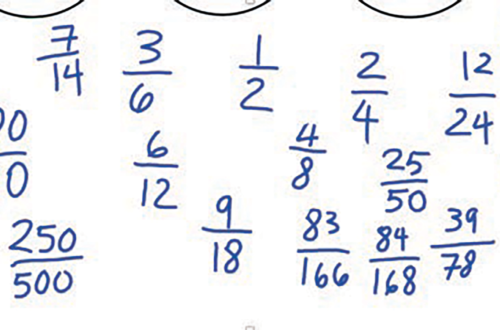Appreciating Perspectives
Each piece in this issue of delta-K invites readers to reflect on their own mathematical experiences with curriculum and pedagogy. Each author’s unique per-spective draws us into seeing more and viewing ideas from different angles, and invites us to engage in metacognitive practices for ourselves and with our students.
Each piece is grounded in a particular aspect of curriculum, but that is not the focus. Rather, what is most enticing is the subtle attention to language, gesture and experience; the invitation to attend to underlying metaphors; and the emotional involvement with mathematics. The authors share opportunities that support collaboration, exploration and frustration in doing mathematics. Most important, they explore building understanding and connections to mathematics, both for teachers’ own connections to the subject and for teachers’ confidence in their pedagogical choices. We are invited to create mathematical conceptualizations as genetic, which, according to Piaget, is to continually construct and reorganize our under-standing and connections, as Nicole Langevin, Miwa A Takeuchi, Jenny Yuen and Shayla Jaques discuss in “Enriching Geometric Understanding Through Early STEM Pedagogy.”
Taking a historical perspective, four articles by preservice teachers feature the enduring impact of female mathematicians past and present—Sophie Germain, Eugenia Cheng, Emmy Noether and Mary Everest Boole. The authors document the journeys and legacies of these gifted and tenacious women, as well as their influence even today.
In a similar pedagogical vein, in “Supporting Pre-service Elementary Teachers’ Growth Through Studying the Historical Development of a Mathemat-ics Topic,” Giang-Nguyen T Nguyen and Tiffany Marlow share how students’ research on the historical development of a mathematics topic contextualized their understanding of the topic’s importance.
Two articles delve into practices that use emotional connections to build students’ confidence and interest in mathematics. In “How Do You Feel? Using Scrib-blers in the Math Classroom to Elicit Mathematical and Personal Connections,” Josh Markle and Raeesa
Shivji explore metacognitive reflection in the mathematics classroom through the use of scribblers. In “Culture—a Vital Part of Mathematics,” Yvette d’Entremont and Michelle Voillot highlight how a cultural practice can lend focus to multiple mathematical concepts. These articles add to teachers’ knowledge of the impact of using personal experiences to build multiple ways of knowing and using mathematics.
Tapping into metacognitive thinking is also evident in Shimeng Liu’s exploration of the metaphors underlying Alberta’s elementary mathematics curriculum, as well as in the cyclical phases to support building understanding of using a problem-solving approach in instruction that was used in the professional development series described by Richelle Marynowski, Shelly Wismath, Verna Mabin, Michelle Campmans, Lynn Suttie and Alana Millard. Reflective practice also plays a role in Jérôme Proulx’s piece about coming to understand students’ perspectives in producing equivalent fractions and in the article by Langevin et al about how teachers can support the development of a more robust understanding of geometric properties by highlighting language, gesture and technology in challenging collaborative projects.
All these pieces remind me how valuable it is for teachers to share their perspectives on teaching and learning with each other. This is especially true during these times, as we acknowledge how important per-sonal connections are in both our relationships with each other and in mathematics, and how we can use this journal as a forum to embrace others’ perspec-tives. The pieces invite us to continue returning to construct and reorganize our understanding of our-selves as learners and of the mathematical topics we explore.
As the acting editor of this issue of delta-K, I have had the immense privilege of engaging with these authors. Thank you for bringing me into discussions on how your pieces came to fruition and the story you wanted to articulate for the journal’s readership. I, too, benefited from this exercise in editing, and I thank you all for sharing your experiences. Let us encourage each other to continue telling our stories of engaging daily in mathematics, both inside and outside the classroom.
Barbara O’Connor






